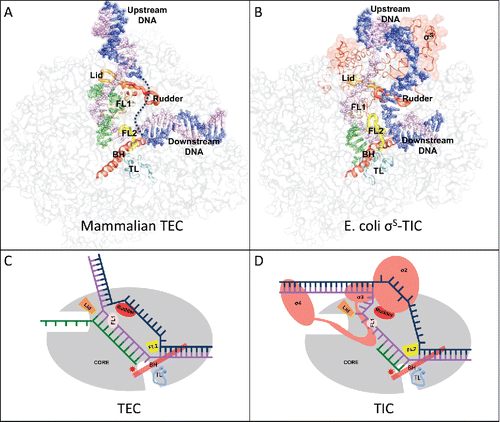Figures & data
Figure 1. (A) The mammalian transcription elongation complex (TEC)Citation18 and (B) the E. coli sS-transcription initiation complex (sS-TIC)Citation17 with a complete bubble. The nucleic acids are shown as colored spheres: nontemplate strand, blue; template strand, purple; RNA, green. The RNAP core enzymes are shown as grey surface diagrams and the structure elements critical for bubble maintenance are shown as colored tubes or ribbons: lid, orange; rudder, red; FL1, wheat; FL2, yellow; BH, red; TL, cyan. (C) and (D) are schematic representations of a post-translocated TEC and a pre-translocated TIC respectively. The TEC contains a 10-nt bubble with no extra unpaired DNA residues at both edges of the bubble.

Figure 2. The steps of the nucleotide addition cycle are related to six basic states E1 to E6 with regard to translocation, NTP/PPi association and active site opening. These six states include three quickly equilibrating groups QE1 (pre-translocated E1 and post-translocated E2), QE2 (NTP-associated E3 and E4) and QE3 (PPi-associated E5 and E6), which are connected by slower diffusion-controlled and chemical reaction steps. E1 and E2 states are also likely equilibrating quickly with others states such as active site closed E0, backtracked E7 and hypertranslocated E8 states. Both E7 and E8 represent ensembles of translocation states, however, it is likely that only the 1-nt backtracking and 1-nt hyper forward translocation states are of significance in many cases. Solid arrows represent rapid processes; dashed arrows represent potentially rate-limiting processes. Some states (such as the active site-open E1, E2, E7 and E8 states) are more ratchetable and could become ratcheted/clamp-opened (E9 states). The off-pathway ratcheting processes (rate constants kr's) are expected to be slower than the on-pathway processes. TL/open, active site-open trigger loop conformation; TH/close, active site-closed trigger helices conformation.

